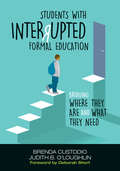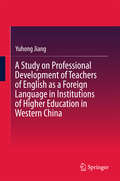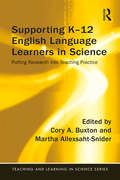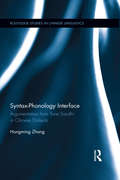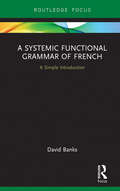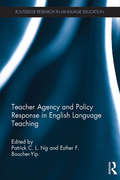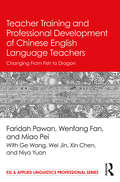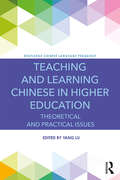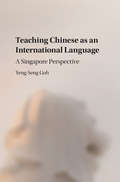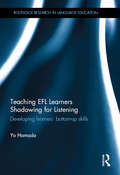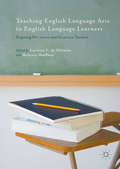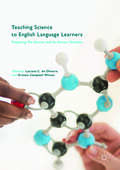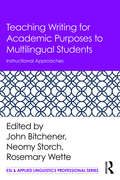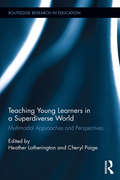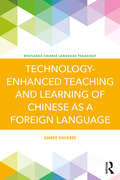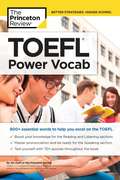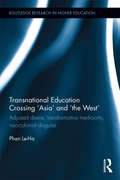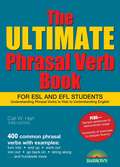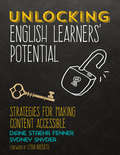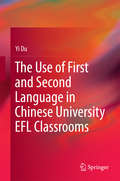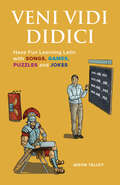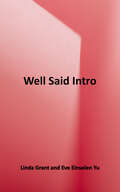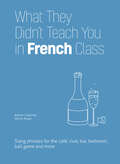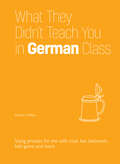- Table View
- List View
Students With Interrupted Formal Education: Bridging Where They Are and What They Need
by Brenda K. Custodio Judith B. O'LoughlinNew hope for our most vulnerable English learners “One of the guiding principles of effective English language teaching is for educators to know their students. And that in a nutshell captures the value of this book. . . . The compassion that Custodio and O’Loughlin feel for our SIFE students, the commitment they have to educating them well, and the comprehension they have of the assets these learners bring to the classroom are evident in the writing, tools, and vignettes they share.” -Deborah J. Short Under the best of circumstances, the academic demands of today’s classrooms can be daunting to our English learners. But for the tens of thousands of newly arrived students with interrupted formal education, even the social challenges can be outright overwhelming. Rely on this all-in-one guide from Brenda Custodio and Judith O’Loughlin for expert insight on how to build the skills these students need for success in school and beyond. Inside you’ll find Essential background on factors leading to interrupted education Specific focus on refugee children and Latino immigrants Guidance on building internal resilience for long-term social and emotional health Recommendations for creating supportive environments at the classroom, school, and district level About one thing, Brenda and Judith are absolutely convinced: our SIFE students can learn and make progress, often at a remarkable speed. But it’s up to us, their educators, to provide the time, attention, and a specific focus. Consider this book your first step forward.
A Study on Professional Development of Teachers of English as a Foreign Language in Institutions of Higher Education in Western China
by Yuhong JiangThis book offers a comprehensive, up-to-date review of the recent professional developments of teachers of English in the western region of China in the context of English language teaching reform and teacher education reform. It discusses a wealth of theories, frameworks, qualitative case studies and quantitative investigations, while also covering a range of key practices that are indispensable. It equips readers with an in-depth understanding of the impact of the current curriculum reform on the promotion of teachers' cognition, emotions, attitudes and awareness of their self-development, as well as teachers' corresponding efforts to update their educational concepts, reassess their teacher roles, enhance their teaching skills, and implement new approaches to their professional development. It is a valuable resource for anyone pursuing research in this field as well as in-service teachers, teacher educators and education administrators. And as it offers practical help for the potential difficulties and challenges they might encounter, it is also a must-read for the student teachers of English.
Supporting K-12 English Language Learners in Science: Putting Research into Teaching Practice (Teaching and Learning in Science Series)
by Cory Buxton Martha Allexsaht-SniderThe contribution of this book is to synthesize important common themes and highlight the unique features, findings, and lessons learned from three systematic, ongoing research and professional learning projects for supporting English learners in science. Each project, based in a different region of the U.S. and focused on different age ranges and target populations, actively grapples with the linguistic implications of the three-dimensional learning required by the Framework for K-12 Science Education and the Next Generation Science Standards. Each chapter provides research-based recommendations for improving the teaching of science to English learners. Offering insights into teacher professional learning as well as strategies for measuring and monitoring how well English learners are learning science and language, this book tells a compelling and inclusive story of the challenges and the opportunities of teaching science to English learners.
Syntax-Phonology Interface: Argumentation from Tone Sandhi in Chinese Dialects (Routledge Studies in Chinese Linguistics)
by Hongming ZhangThis book centers on theoretical issues of phonology-syntax interface based on tone sandhi in Chinese dialects. It uses patterns in tone sandhi to study how speech should be divided into domains of various sizes or levels. Tone sandhi refers to tonal changes that occur to a sequence of adjacent syllables or words. The size of this sequence (or the domain) is determined by various factors, in particular the syntactic structure of the words and the original tones of the words. Chinese dialects offer a rich body of data on tone sandhi, and hence great evidence for examining the phonology-syntax interface, and for examining the resulting levels of domains (the prosodic hierarchy). Syntax-Phonology Interface: Argumentation from Tone Sandhi in Chinese Dialects is an extremely valuable text for graduate students and scholars in the fields of linguistics and Chinese.
A Systemic Functional Grammar of French: A Simple Introduction
by David BanksA Systemic Functional Grammar of French provides an accessible introduction to systemic functional linguistics through French. This concise introduction to the systemic functional grammar (SFG) framework provides illustrations throughout that highlight how the framework can be used to analyse authentic language texts. This will be of interest to students in alternative linguistic frameworks who wish to acquire a basic understanding of SFG as well as academics in related areas, such as literary and cultural studies, interested in seeing how SFG can be applied to their fields.
Teacher Agency and Policy Response in English Language Teaching (Routledge Research in Language Education)
by Patrick C. Ng Esther F. Boucher-YipThe role of English in the global arena has prompted official language-in-education policy makers to adopt language education policies to enable its citizens to be proficient in English and to access knowledge. Local educational contexts in different countries have implemented English education in their own ways with different pedagogical goals, motivations, features and pedagogies. While much of the research cited in English language planning policy has focused on macro level language policy and planning, there is an increasing interest in micro planning, in particular teacher agency in policy response. Individual teacher agency is a multifaceted amalgam, not only of teachers’ individual histories, professional training, personal values and instructional beliefs, but also of how these interact with local interpretations and appropriations of policy. Teacher Agency and Policy Response in English Language Teaching examines the agency of the teacher in negotiating educational reforms and policy changes at the local and national levels. Chapters in the book include: English language teaching in China: teacher agency in response to curricular innovations Incorporating academic skills into EFL curriculum: teacher agency in response to global mobility challenge Teacher agency, the native/nonnative dichotomy, and "English Classes in English" in Japanese high Schools Teacher-designed high stakes English language testing: washback and impact This book will appeal to researcher across all sectors of education, in particular key stakeholders in curriculum and language planning. Those interested in the latest development of English language teaching will also find this book a valuable resource.
Teacher Training and Professional Development of Chinese English Language Teachers: Changing From Fish to Dragon (ESL & Applied Linguistics Professional Series)
by Faridah Pawan Wenfang Fan Pei MiaoThis up-close look at Chinese ESL teachers documents undertakings at formal and informal levels to support and sustain their expertise in ways that balance collaborative and competitive efforts, situated and standards-based programs, ethnically responsive and government-based efforts, and traditional and 21st-century teaching visions. English is a mandated subject for approximately 400 million Chinese public school students. Making transparent the training and professional development received respectively by pre-service and in-service teachers, this book provides a rare window into how Chinese English Language teachers (ELTs) reconcile the two needs with the responsibility to teach large numbers of students while also navigating societal, cultural, and institutional cross currents. It also explores the range of ways China invests in the training and professional development of its English language teachers.
Teaching and Learning Chinese in Higher Education: Theoretical and Practical Issues (Routledge Chinese Language Pedagogy)
by Yang LuTeaching and Learning Chinese in Higher Education deals with the current issues and challenges faced by teachers and learners of Chinese. Written by leading professionals and academics, the book is the first collection of research articles based on data collected in higher education institutions in the UK. The studies focus on concerns related to learners of Chinese as a foreign language (CFL) and aim to establish studies on teaching Chinese as a foreign language (TCFL) as part of the mainstream of applied linguistics The contributors have applied their theoretical backgrounds in applied linguistics and education to tackle issues such as how to benchmark the Chinese written language with CEFR, how to integrate standardised Chinese proficiency tests with institutional assessments and teaching methodologies. Teaching and Learning Chinese in Higher Education will be invaluable to professionals, academics and students seeking theoretical frameworks in applied linguistics for TCFL.
Teaching Chinese as an International Language: A Singapore Perspective
by Goh Yeng-SengBilingual and bicultural scholar Yeng-Seng Goh offers the first in-depth English language analysis of global Chinese, exploring the spread of Chinese beyond China and its emergence as a global language. Approaching the topic from a Singapore perspective, Goh uses this fascinating language ecosystem, with its unique bilingual language policy, as a case study for Chinese language learning. Offering clear insights into the pedagogy of teaching Chinese as an international language (TCIL), this book covers a range of important topics, such as the use of English in the teaching of Chinese, the teaching of Chinese by non-native teachers, information and communications technology in L2 learning and teaching, and the progressive testing of receptive skills. In doing so, it presents a new, integrative approach to the compilation of Chinese learner's dictionaries, an innovative bilingual hybrid model for training TCIL teachers, and a solid theoretical framework for Masters of Arts programmes in TCIL.
Teaching EFL Learners Shadowing for Listening: Developing learners' bottom-up skills (Routledge Research in Language Education)
by Yo HamadaShadowing, an active and highly cognitive technique for EFL listening skill development, in which learners track heard speech and vocalize it simultaneously, is gradually becoming recognized. However, there remain a lot of mysteries and misunderstandings about it. This book uncovers shadowing in terms of theory and practice. This book cements shadowing as a separate technique from other similar techniques such as Elicited Imitation, Mirroring, and simple repetition, and provides ample empirical data to explain the function of Shadowing. It also elaborates on how Shadowing should be used in terms of materials, procedure, and learners’ psychology, which would aid in instructors’ use of Shadowing in teaching. A guide on a method effective in improving learners’ bottom-up listening skills, this book will certainly prove useful to English Language learners and instructors in their linguistic pursuits.
Teaching English Language Arts to English Language Learners
by Luciana C. Oliveira Melanie ShoffnerThis book focuses on the ways in which English language arts (ELA) pre-service and in-service teachers have developed - or may develop - instructional effectiveness for working with English language learners (ELL) in the secondary English classroom. Chapter topics are grounded in both research and practice, addressing a range of timely topics including the current state of ELL education in the ELA classroom, and approaches to leveraging the talents and strengths of bilingual students in heterogeneous classrooms. Chapters also offer advice on best practices in teaching ELA to multilingual students and ways to infuse the secondary English teacher preparation curriculum with ELL pedagogy. Comprehensive in scope and content and examining topics relevant to all teachers of ELLs, teacher educators and researchers, this book appeals to an audience beyond ELA teachers and teacher educators.
Teaching Science to English Language Learners
by Luciana C. de Oliveira Kristen Campbell WilcoxThis edited collection explores how science can be taught to English language learners (ELLs) in 21st century classrooms. The authors focus on the ways in which pre-service and in-service science teachers have developed--or may develop--instructional effectiveness for working with ELLs in the secondary classroom. Chapter topics are grounded in both research and practice, addressing a range of timely topics including the current state of ELL education in the secondary science classroom, approaches to leveraging the talents and strengths of bilingual students in heterogeneous classrooms, best practices in teaching science to multilingual students, and ways to infuse the secondary science teacher preparation curriculum with ELL pedagogy. This book will appeal to an audience beyond secondary content area teachers and teacher educators to all teachers of ELLs, teacher educators and researchers of language acquisition more broadly.
Teaching Writing for Academic Purposes to Multilingual Students: Instructional Approaches (ESL & Applied Linguistics Professional Series)
by John Bitchener Neomy Storch Rosemary WetteExamining what is involved in learning to write for academic purposes from a variety of perspectives, this book focuses in particular on issues related to academic writing instruction in diverse contexts, both geographical and disciplinary. Informed by current theory and research, leading experts in the field explain and illustrate instructional programs, tasks, and activities that help L2/multilingual writers develop knowledge of different genres, disciplinary expectations, and expertise in applying what they have learned in both educational and professional contexts.
Teaching Young Learners in a Superdiverse World: Multimodal Approaches and Perspectives (Routledge Research in Education #190)
by Heather Lotherington Cheryl PaigeThis book documents a collaborative action research project in one school where researchers and practitioners worked together to develop multimodal literacies and pedagogies for diverse, multilingual elementary classrooms. Following chronologically from Lotherington’s Pedagogy of Multiliteracies (2011), this volume picks up after teachers and researchers have learned how to work efficiently as a learning community to offer project-based learning approaches. This edited collection relates how teachers and students of different grade levels, language backgrounds, and abilities developed a shared agenda and created a framework for effective and inclusive practices. Contributors demonstrate that collaboration, creative pedagogical solutions and innovative project-based learning are all essential parts of learning and teaching socially appropriate and responsive literacies in a multimodal, superdiverse world.
Technology-Enhanced Teaching and Learning of Chinese as a Foreign Language
by Amber NavarreTechnology-Enhanced Teaching and Learning of Chinese as a Foreign Language provides new and experienced teachers of Chinese with a timely review and evaluation of the use of technology in the language classroom. The book draws from Second Language Acquisition theories and empirical studies to demonstrate the use of technologies in facilitating language learning. With a strong practical and pedagogical focus, this is an ideal resource for current and prospective teachers of Chinese as a Foreign Language. Key features include: Demonstration and analysis of technologies in use Principles and methods to evaluate instructional technologies Summary tables presenting the key functions of each technology tool Online resources include up-to-date information on new technologies and tools to address the ever-changing nature of the topic.
TOEFL Power Vocab: 800+ Essential Words to Help You Excel on the TOEFL
by Princeton Review800+ WORDS TO HELP YOU EXCEL ON THE TEST OF ENGLISH AS A FOREIGN LANGUAGE!• Boost your knowledge for the Reading and Listening sections• Master pronunciation and be ready for the Speaking section• Test yourself with 70+ quizzes throughout the bookImproving your vocabulary is one of the most important steps you can take to feel more confident about the Test of English as a Foreign Language. The Princeton Review's TOEFL Power Vocabulary has the words, tools, and strategies you need to help boost your comprehension levels and improve your score, including:• 800+ frequently-appearing TOEFL exam words • In-context examples and secondary definitions that help focus your study sessions• Mnemonic devices and root guidelines that expand your vocabulary• Brief vocab sections that break down content and let you work at your own pace• Quick quizzes with varied drills (definitions, word pairs, synonyms, antonyms, and more) to help cement your knowledge• Final drill section at the end of the book so you can assess your progress
Transnational Education Crossing 'Asia' and 'the West': Adjusted desire, transformative mediocrity and neo-colonial disguise (Routledge Research in Higher Education)
by Le-Ha PhanIn this book, Phan Le-Ha identifies and discusses four growing self-sustained/sustaining fundamental phenomena in transnational education (TNE), namely (1) the planned, evolving and transformative mediocrity behind the endorsement of English-medium education legitimized by the interactive Asia-the West relationship; (2) the strategic employment of the terms ‘Asia/Asian’ and ‘West/Western’ by all stakeholders in their perceptions and construction of choice, quality, rigour, reliability and attractiveness of programs, courses, and locations; (3) the adjusted desire for an imagined (and often misinformed) ‘West’ among various stakeholders of transnational education; and (4) the assigned and self-realized ownership of English by otherwise normally on-the-margin groups of speakers. A focus on how these phenomena impact questions of identity and desire in TNE is a running theme. The above phenomena are discussed against the backdrop of ‘the rise of Asia’ sentiment and how this sentiment has played out in interactions and relationships between ‘the West’ and ‘Asia’ and among Asian institutions and various entities. Phan Le-Ha’s examination of the identified phenomena in TNE has been informed by her multi-layered engagement with the dialectic of the Asia-the West relationship, her critical take on certain pro-Asia and decolonisation scholarship, and her interdisciplinary and multidisciplinary approach to theorise the field and the specific topic under scrutiny. Phan Le-Ha shows that the current Asia chooses (not necessarily by force but largely by will and often with an informed and well-articulated agency) to go with the idea of the West and often desires an affiliation with the West either directly or indirectly, something that is getting more intense in the context of globalization, regionalization, and commercialization of education. The rise of Asia has made the idea of the West even more looked-for in Asia. TNE in Asia, in many ways, is the transforming and dynamic transit point, a layover that facilitates entry into a wanted destination – the West and/or the idea of the West. The West and Asia need one another more than ever in the context of the internationalization and commercialization of higher education. What’s more, the West and Asia have hardly ever been mutually exclusive but have rather been in an eventful love-and-obsession relationship with each other. This is the very dialectic proposition that Phan Le Ha takes throughout this book while paying specific attention to transnational higher education in the greater Asian region including the Middle East, following her several research projects conducted in the region since 2005 to date. Transnational Education Crossing 'the West' and 'Asia' explores: • English, Internationalisation of Higher Education, and Identity: Increasing Academic Monolingualism and English-only Package • Transnational Education and Dream Realization: From the Philippines to Vietnam, From Afghanistan to Dubai, From Everywhere in Asia to Thailand • Desiring International /Transnational Education: Theorisation of Key Concepts and Next Steps from Here The book will be of interest to researchers in the field of transnational education, Asia education and education policy.
Ultimate Phrasal Verb Book, 3rd edition: For Esl And Efl Students
by Carl W. HartUpdated to reflect questions found on the most recent ESL tests, this book presents 400 common phrasal verbs as they are used in everyday English. Phrasal verbs are verbs combined with prepositions or adverbs. Familiarity with phrasal verbs and understanding their use as nouns (breakup, showoff, etc.) or adjectives (spaced-out, broken-down, stressed-out, and many others) is essential to ESL students. Updated information includes: the most commonly used phrasal verbs; activities and examples that reflect our current technology and the world around us; an expanded introduction for the teacher with a thorough breakdown and explanation of phrasal verbs; and, a discussion of separable and inseparable phrasal verbs in Unit I, and more. This book’s hundreds of examples in context and hundreds of exercises will be extremely useful to ESL students who are preparing for TOEFL or who simply wish to improve their English.
Unlocking English Learners' Potential: Strategies for Making Content Accessible
by Diane Staehr Fenner Sydney C. Snyder“Schools are not intentionally equitable places for English learners to achieve, but they could be if the right system of support were put in place. Diane Staehr Fenner and Sydney Snyder recommend just such a system. Not only does it have significant potential for providing fuller access to the core curriculum, it also provides a path for teachers to travel as they navigate the individual needs of students and support their learning journeys.” —Douglas Fisher, Coauthor of Visible Learning for Literacy A once-in-a-generation text for assisting a new generation of students Content teachers and ESOL teachers, take special note: if you’re looking for a single resource to help your English learners meet the same challenging content standards as their English-proficient peers, your search is complete. Just dip into this toolbox of strategies, examples, templates, and activities from EL authorities Diane Staehr Fenner and Sydney Snyder. The best part? Unlocking English Learners’ Potential supports teachers across all levels of experience. The question is not if English learners can succeed in today’s more rigorous classrooms, but how. Unlocking English Learners’ Potential is all about the how: How to scaffold ELs’ instruction across content and grade levels How to promote ELs’ oral language development and academic language How to help ELs analyze text through close reading and text-dependent questions How to build ELs’ background knowledge How to design and use formative assessment with ELs Along the way, you’ll build the collaboration, advocacy, and leadership skills that we all need if we’re to fully support our English learners. After all, any one of us with at least one student acquiring English is now a teacher of ELs.
Unlocking English Learners' Potential: Strategies for Making Content Accessible
by Diane Staehr Fenner Sydney C. Snyder“Schools are not intentionally equitable places for English learners to achieve, but they could be if the right system of support were put in place. Diane Staehr Fenner and Sydney Snyder recommend just such a system. Not only does it have significant potential for providing fuller access to the core curriculum, it also provides a path for teachers to travel as they navigate the individual needs of students and support their learning journeys.” —Douglas Fisher, Coauthor of Visible Learning for Literacy A once-in-a-generation text for assisting a new generation of students Content teachers and ESOL teachers, take special note: if you’re looking for a single resource to help your English learners meet the same challenging content standards as their English-proficient peers, your search is complete. Just dip into this toolbox of strategies, examples, templates, and activities from EL authorities Diane Staehr Fenner and Sydney Snyder. The best part? Unlocking English Learners’ Potential supports teachers across all levels of experience. The question is not if English learners can succeed in today’s more rigorous classrooms, but how. Unlocking English Learners’ Potential is all about the how: How to scaffold ELs’ instruction across content and grade levels How to promote ELs’ oral language development and academic language How to help ELs analyze text through close reading and text-dependent questions How to build ELs’ background knowledge How to design and use formative assessment with ELs Along the way, you’ll build the collaboration, advocacy, and leadership skills that we all need if we’re to fully support our English learners. After all, any one of us with at least one student acquiring English is now a teacher of ELs.
The Use of First and Second Language in Chinese University EFL Classrooms
by Yi DuThis book investigates first language (L1) and second language (L2) use in Chinese university classrooms, focusing on the experiences of four Chinese EFL teachers who were teaching non-English major students at four different proficiency levels. It examines these four teachers' actual use of L1 and L2, including the distribution of their L1 and L2 use; the circumstances, functions and grammatical patterns of their language use; and their language use across different frames of classroom discourse. It also explores their attitudes and beliefs regarding this issue in depth, as well as their own perceptions of and reasons for their language use and possible influencing factors. Through its detailed analysis of the teachers' language use, as well as their respective beliefs and decision-making techniques, this book contributes to L2 teachers' professional development and L2 teaching in general, especially with regard to establishing a pedagogically principled approach to L1 and L2 use.
Veni Vidi Didici: Have Fun Learning Latin with Songs, Games, Puzzles and Jokes
by Jason TalleyAn engaging Latin guide filled with all sorts of fun and laughs that make learning the language a blastSeize the day with a fun, new guide to the ultimate language. Whether you&’re looking to show up your teacher or have a laugh with friends, Veni Vidi Didici will give you the knowledge to drop some Latin that&’s sure to impress, including:• Cool Slang• Lighthearted insults• Funny Jokes• Timeless Games• Famous Sayings• Clever PuzzlesVeni Vidi Didici goes beyond basics, offering silly stories and historical factoids that will keep you entertained for hours.
Well Said Intro (Well Said, New Edition Series)
by Linda Grant Eve Einselen YuThe Well Said series is designed to improve the pronunciation and communication skills of beginner to advanced students from all language backgrounds. It offers a clear course plan covering the essential areas of pronunciation, including stress, rhythm, and intonation--features that research shows help students the most. Additionally, there are over fifty pages of supplemental activities focusing on consonant and vowel sounds. The Intro level of Well Said is a slower-paced course that introduces the most important pronunciation features at the beginning to low-intermediate level. A free Website for teachers and students includes the full audio program.
What They Didn't Teach You in French Class: Slang Phrases for the Cafe, Club, Bar, Bedroom, Ball Game and More
by Henry Rowe Adrien ClautrierSipping a café au lait at a sidewalk bistro...Getting down at Paris&’s hottest club...Cheering on Les Bleus at the stadium...Drop the textbook formality and chat with the locals in France&’s everyday language.• What&’s up? Ça va?• She&’s totally hot. Elle est bandante.• This party is lit! Cette bringue est enflammée!• That brie smells funky. Ce brie sent putain de drôle.• Wanna French kiss? On se roule une pelle?• That ref is a moron. L&’arbitre est un abruti.
What They Didn't Teach You in German Class: Slang Phrases for the Cafe, Club, Bar, Bedroom, Ball Game and More (Dirty Everyday Slang)
by Daniel ChaffeyDrinking a Hefeweizen at a Biergarten...Dancing at Berlin&’s hottest club...Cheering for the local soccer team at the Stadion...Drop the textbook formality and chat with the locals in Germany&’s everyday language.• What&’s up? Wie geht&’s?• He/She is a real hottie. Er/Sie ist eine ganz heiße Nummer.• What&’s on tap? Was gibt&’s vom Fass?• I ordered the Currywurst. Ich bin den Currywurst.• Do you wanna cuddle? Willst Du kuscheln?• Gooooooal! Toooooor!
